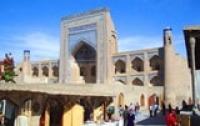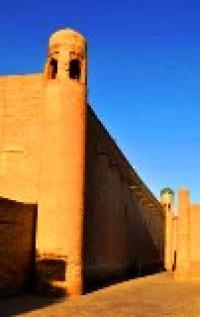You are here
Alla Kuli-khan Madrasah.



Excursions on madrasahs in Khiva.
“Abulgazi Allakuli Shah,
with daintiness of Allah graced the science of the country;
Oh, God, generosity clouds filling with water of galore
Turn all its place into the river of knowledge,
With his magnanimity this madrassah has built,
Turned it into hearts of the enlightened,
Has the abode of the knowledge.
Its dome surpasses the dome of the heavens,
Decoration of sciences adorns his stature,
Majestic domes of this structure,
Are lit from head to toe with glow of science.
Come hey, who scribe to pick his story,
Say: - "A source of a charm and"
"Faiz ilm wa foydali Manbai". The source of blessing and useful knowledge.
First tours in Khiva.
The ruler (Khan) of Khiva Alla Kuli-khan (1825 - 1842) in order to transform the city of Khiva into one of the beautiful and attractive cities in Asia, having proceeded from his capabilities, undertook large construction and improvement works.
Having disassembled dilapidated and already decaying old madrassahs, most of which were built of mud brick and wooden frame, ordered the skilled craftsmen of that time to build on their place madrassahs built of burnt bricks.
To this raw relates beautiful madrasah built by him in his name, on the site of the eastern ramparts of Ichan-Qala. Before the construction part of the fortress city wall adjoining the madrassah Hodzhamberdibiy and some domes of Palvan Darvaza gate were dismantled.
Residues of pakhsa and brick walls were leveled and on their place portal of the madrasah was erected. This portal settled down opposite to the portal across to the madrasah Qutlugh Murad Inak.
As a result on the newly founded square the traditional architectural form kosh (pair) madrasah was formed. As a result of raising of Alla Quli Khan madrasah on an artificial platform of 3 meters high it was succeeded to raise it considerably over the low domes of the next madrasah of Hodzhamberdibiy which was in front of it and thus to include the madrasah into the territory of the inner part of the city.
Some difference from traditional forms has an appearance of the yard of the madrasah - a row of two-storey hujras (cells) set over small domes of Palvan-Darvaza gate and partially at edges of domes of the Tim.
Madrasah has the form of a trapezoid, there are 99 hujras in it, summer and winter mosques and darskhana (audience). Each hujras has a door and a small window above it. At the bottom hujras are paved with square baked bricks, walls plastered with ganch (alabaster), in the inner cover hujras are of the «Balkhi" type, without decorations.
Large premises madrasah like winter and summer mosques do not have large dome as a two-story structure, arches, smooth without decorations walls, deep niches have some unsightly appearance. But the external decorations madrassah quite differs.
If for construction of Madrasah Qutlugh Murad Inak white and color ganch, relief stamped terracotta glazed majolica were used, for adornments of this madrassah only majolica was used.
But majolica patterns differ from each other and ceramists while selecting decorations paid attention to the their location and selected forms of panels with a great skill, as well as, to the thickness of paint and size of the pattern pieces.
Floral pattern on a portal, a series of delicate arches enliven dull monotony of the girikh (forms of geometric design). The portal of the mosque in the courtyard of madrasah is decorated with complicated annular ring-shaped floral patterns, here there is the entrance to the summer mosque.
Typically, the back side of the main portal madrasah was devoid of decoration, here in this place, we see a remarkable painting of openwork floral patterns on majolica. The history of construction of madrassah in the different periods was written differently.
About this ustaz (the Mentor) historian Ogahi in his work "Riёz ud-Dawla" ("Gardens of grandeur") cites the following: - "In the year of the sheep (Aries), in 1251 (year of Hijra) (1835) at the behest of Alla Quli Khan, under the guidance of Mohammed Yusuf mihtar Tashhauz fortress was built.
"The highest madrassah" ("Madrasai Oliya") is located in Khiva between the caravanserai and the gate Pakhlavan Darvaza construction of which was begun headed by Mohammed Riza kushbegi. After his death the construction headed by Atamurat kushbegi up to its completion.
It has the name "Madrasai khan" ("Madrasah of khan"). According to the recollections of old residents of Khiva, onсe (precisely in 1961) on a small column, an inscription indicating 1834 decorated the gate of madrassah.
Our teacher Kamiljan aka Khudaibergenov in his pamphlet entitled "Hiva honlari shajarasi" ("Genealogy of Khiva Khans"), focusing on the history of the madrassahs Alla Quli Khan expressed the following opinion: - "In the cartouche of a portal of madrassah on a majolica the following words were written in Arabic script of nastaliq style: - Thanks to Allah the Almighty this eye pleasing abode a source of the benefit and abundance was built at the behest of the great son of His Majesty the Sultan Muhammad Rahim Padishah the Ghazi (the fighter for the faith, let there be beam in his grave), of His Majesty Sultan's great and respected Khaqan (lord) Abulghazi Allakuli Khorezmshah (let his rule last eternally), in the year 1250 ".
The madrasah was built in 1250 Hijra, i. e. in 1834 by modern chronology. On the whole portal of the madrasah in the form of letter U in an extremely beautiful and at the same time a hardly readable style, in Suls script of Arabic letters the Surah Fath (Victory) from the Koran is written.
On the wall of the balcony above the entrance door to the madrasah in nastaliq style of Farsi derived the chronogram in verses: In the last lines of this verse the chronogram is encrypted when calculating which 1250 Hijra comes out.
Hence, the construction of madrasah was started in 1834 and was completed in 1835. Alla Quli Khan as waqf for this madrasah allocated 8500 tanap (about 9000 hectares) of land under the jurisdiction of the Khanate of Khiva. Nowadays Madrasah refurbished and today the artisanal center is settled down here.
Authority:
http://welcomeuzbekistan.uz
Photos by
Alexander Petrov.







